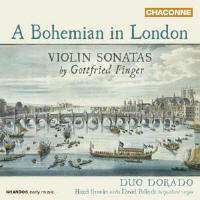Texte paru dans: / Appeared in: |
|
|
Outil de traduction ~ (Très approximatif) |
|
|
Reviewer: Michael
De Sapio
One of the “genres” I love
best is virtuoso solo violin music of the 17th century, most brilliantly
represented by the Austro-Germans Schmelzer, Biber, and Walther. I am
grateful that the early music movement of the last few decades has allowed
us to get to know a body of work which, in addition to pointing the way to
Bach’s masterpieces for the violin, provides a rich reservoir of stimulating
music to be enjoyed for its own sake. Now the English musicians Hazel Brooks
and David Pollock (collectively Duo Dorado) have uncovered a group of
previously unknown sonatas by Gottfried Finger (1655–1730).
Brooks’s copious program notes
inform us that Finger was, like his older contemporary Biber, a
German-speaking composer born in the Moravia region of Bohemia. He
immigrated to London in 1685 and contributed to the city’s musical life as a
violinist, including in the theater, collaborating with the luminaries
Purcell and Eccles. He was briefly employed in King James II’s Catholic
Chapel and published the first set of solo sonatas ever printed in England.
Things turned sour when Finger lost a “Prize Musick” composing competition
to a younger, more fashionable composer, and he left England in disgust,
apparently convinced that his being foreign and Catholic had played a role
in the verdict. Finger came to London at a time when the violin was
beginning to overtake the viola da gamba in popularity. He played and wrote
music for both instruments, but his violin music must have startled English
audiences with its display of what the instrument could do.
The sonatas on this disc do
not come from Finger’s published collection, but from manuscripts that
Brooks found in the British Library. This is presumably their first
recording. Brooks relates the sonatas to the stylus fantasticus style: short
sections that alternate among slow sustained arias, brilliant improvisatory
toccatas, tuneful dances, and impassioned recitatives, all linked together
unpredictably in a mosaic style. Unsurprisingly for this period, there are a
few movements based on ground basses. Finger catered to the taste of his
host country in some movements, which have the flavor of English country
dances or of the Purcellian school, but the general style is an amalgam of
the Italian and German. These 13 sonatas keep to a limited cycle of keys
that curiously excludes G Major or Minor. Brooks mentions in her notes that
the ordering of keys was carefully contrived in deference to meantone
temperament, the tuning also adopted for this recording.
As much as I would have loved
to have discovered a rare gem, my feelings about the music and the
performances are mixed. Finger does not possess Biber or Schmelzer’s quality
of melodic invention—nor that of J. J. Vilsmayr, whose Partitas for
Unaccompanied Violin are worthy of exploration. In contrast to the intricate
artfulness of Biber’s sonatas, Finger’s seem almost casually and
spontaneously thrown together. Brooks shines in the sparkling passage work,
which she plays cleanly and brilliantly. I find her somewhat less effective
in the lyrical, sustained movements, where her phrasing can be a bit awkward
and she and her partner do not always prevent the music from feeling
stagnant.
In a time when we routinely
hear fussy and overblown continuo, Duo Dorado has hit upon an elegant
solution: They play some of the sonatas with organ and some with
harpsichord. No plucked or sustaining bass instrument (or tambourine, for
that matter) is heard, which I find refreshing. It seems performers are
starting to realize that the duo format is an authentic solution for
performing Baroque solo sonatas. I see a recording of Finger’s ensemble sonatas listed in the Fanfare Archive, but none of his solo violin sonatas. Thus, Duo Dorado has presented something that didn’t exist before. While there are no grand revelations here, those interested in violin music of this period should give this interesting minor figure a listen. | |
|
|
|
|
Cliquez l'un ou l'autre
bouton pour découvrir bien d'autres critiques de CD |
|




